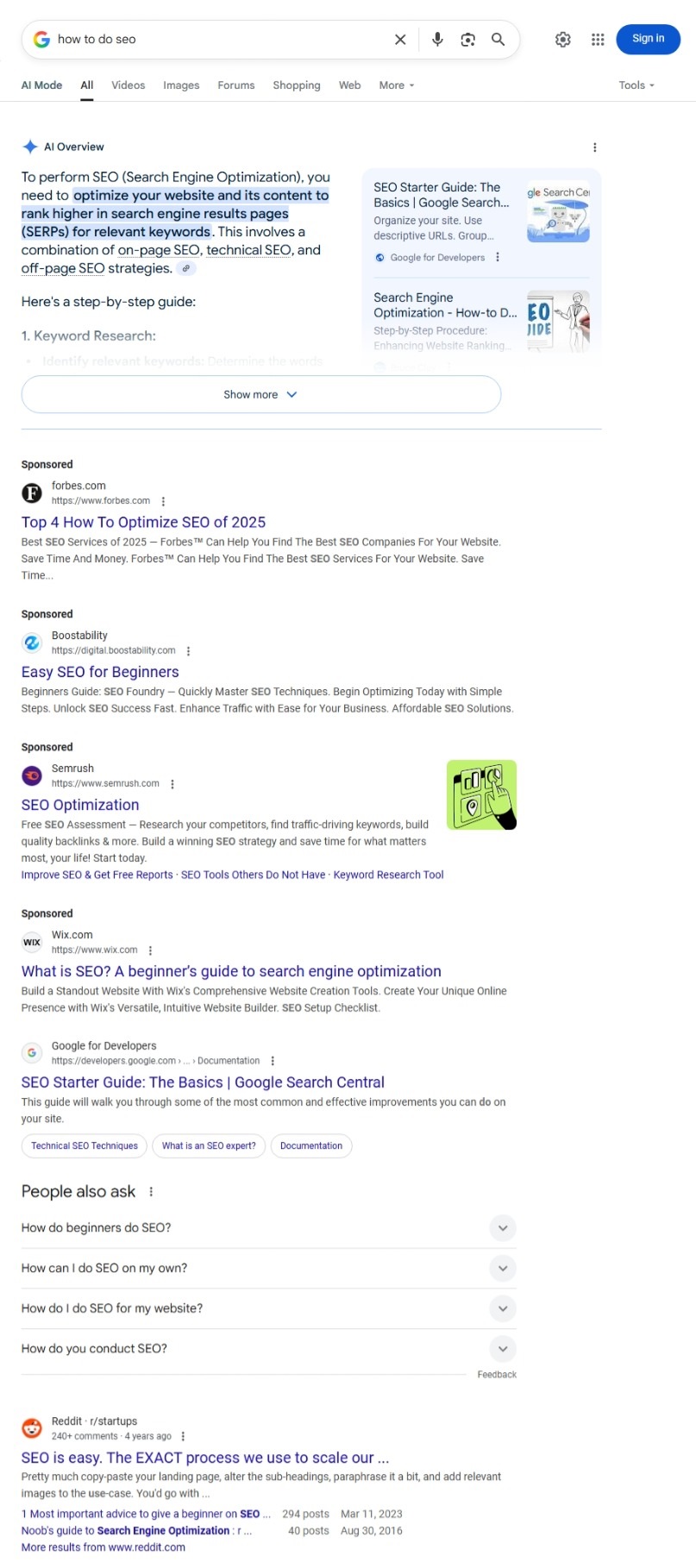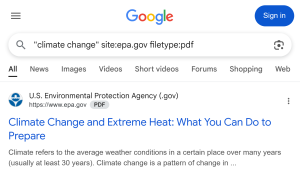Searching for Information
Google and Other Search Engines
Learning Objectives
- Describe how search engines like Google gather, organize, and rank information.
- Evaluate search engine results critically by practicing click restraint.
- Use search operators, like quotation marks and site limits, to improve the relevance of your search results.
Overview
Do you need directions to a friend’s new apartment? Want to find that website your adviser recommended? Looking to rent your textbooks for next semester? Our instinct is often to Google the information we need.
You’re not alone if your preferred search engine is Google. As of 2025, Google holds about 87% of that market in the United States, followed by Bing, Yahoo!, and DuckDuckGo. Increasingly, many people also use social-media apps like TikTok and Instagram to search for information.
Technically speaking, search engines are computer programs that capture content on the open web and make it searchable through a user interface, listing results according to relevance determined by the system. Search engines like Google can be especially helpful at the start of a research project when you’re exploring a new topic or looking for general background information.
In this chapter, we’ll look at how search engines work, how to use them more effectively, and how to critically evaluate the results you get.
How Search Engines Work
Google and other search engines use computer programs called “crawlers,” to scan and collect content from across the internet. These crawlers follow links from one page to another, building an index of what they find. But because crawlers can only include what is publicly available, Google’s index includes just a portion of the web.
Content that is available online but not indexed by search engines is known as the “deep web” (not to be confused with the “dark web,” which is only accessible with special tools and is associated with illegal activity). Many scholarly articles exist behind paywalls and are not available in standard search results. Some social-media sites and posts, forums, and other password-protected content is also considered part of the deep web.
How Results Are Ranked
Google uses a proprietary ranking algorithm to determine the order of search results. While the exact details are not publicly available, we know that ranking is based on many factors, including:
- How well a page’s text matches your search
- How many other websites link to the page
- How popular the page is with other users
- How recently it was updated
- Your location and language
- Your search and browsing history
- How fast the page loads
Because Google adjusts results based on both context and personalization, two people searching the exact same phrase may see different results. Context-based customization includes factors like your location, language, and device type. Personalization goes a step further and uses data from your Google account, such as your past searches and browsing history to tailor results.
This system often works well, but the top results may not be the best sites for your intended purpose. Google doesn’t really know your search intent or how credible a page may be.
Advertising and Optimization
Website owners want their pages to be ranked highly and use search engine marketing techniques to drive traffic. They can use paid advertising to appear at the top of search results (sponsored links) or design their content to align with search engines’ ranking factors (a process known as “search engine optimization” or “SEO” for short).
Sponsored links are advertisements that often appear at the top of your search results. This means that someone has paid to have their website appear at the top of a specific web search. Depending on the search engine you’re using, it may not always be easy to identify these ads from regular (organic) search results. Look for the word “Sponsored” or “Ad” in small font. Advertisements are a chief source of revenue for Google and other web search engines, and they are placed prominently in your search results to generate income from advertisers.
Search engine optimization is a marketing strategy that includes “all measures that improve the visibility of certain documents or websites on the result pages of search engines.” Some of the techniques include how pages are structured with HTML, strategically using likely search keywords and phrases, and ensuring fast page load time.
Sponsored or highly optimized content isn’t necessarily bad, but some websites may be more focused on getting more traffic (and corresponding ad revenue) than producing high-quality information.
Review Search Results
Don’t just click the first result! Use a strategy called “click restraint“: scroll through the page and look at the titles, snippets, and URLs, and consider which might be most useful. Watch this video from iCivics and the Digital Inquiry Group for more on click restraint:
Look at the following results page:

After the “AI Overview,” the first four results are paid advertisements, indicated by the word “Sponsored.” The first organic (non-paid) result is “SEO Starter Guide” on Google for Developers.
AI Overviews
Google and other search engines sometimes will include AI-generated summaries that try to answer your searches. Like other forms of generative AI, they can:
- Include incorrect or outdated information
- Misinterpret jokes, satire, or nuance
- Link to sources that don’t actually support the AI summary
Treat AI overviews with caution. In many cases, you will be better served by selecting a promising link in the search results.
Search More Effectively
Search operators are simple tricks that help you narrow, broaden, or refine your search. They can filter out unrelated results or focus on specific sources. We’ll explore a few of them.
Specify a Domain or Website
Use site: to search within a specific website or domain. A top-level domain is a group of websites whose URLs end in the same letters, such as “.edu,” “.gov,” “.org,” and “.com.”
Example: You could limit your results to government websites by adding site:.gov to your search. If you only wanted information from the Environmental Protection Agency, you could use site:epa.gov
Keep in mind that, despite common belief, “.org” websites are not automatically more trustworthy than “.com” sites. Anyone can make a “.org” website; it is not limited to non-profit organizations. It’s important to evaluate who is behind a website, regardless of the top-level domain.
Specify a Document Type
The names of computer documents have specific filetype endings, like .docx for Word documents, .pptx for PowerPoint presentations, and .pdf for PDFs. You might guess where this is going: we can narrow down our searches to a specific filetype.
Example: Official documents, research reports, and forms often are saved as PDFs, so if you are looking for that kind of information, you could add filetype:pdf to your search.
Minus Sign
Use a minus sign to exclude words or phrases from your results.
Example: If you are looking for information about Green Bay, but not the football team, you might search “Green Bay” -Packers
Quotation Marks
Quotation marks can help make your searches more precise, but they aren’t always necessary. When you put quotation marks around a word or phrase, most search tools will look for that exact phrase in that exact order. It can be useful when you’re searching for names of people, specific quotes, titles of works, and unique phrases.
Quotation marks are best used when you’re confident about the wording and want to limit unrelated results. For broader topics or when you’re still exploring, it’s often better to leave quotation marks off.
Example: If you want to find information about the scholarly journal Nature Medicine, you might search “Nature Medicine” with the quotation marks. Without them, the search may be more likely to return unrelated content about natural remedies.
You can combine multiple search operators into a single search:

Google Scholar
Google Scholar is a free search tool designed to help you find academic sources like journal articles, books, theses, dissertations, and more. It looks a lot like regular Google but is focused on scholarly content across a wide range of subjects. This makes it a good place to start exploring a research topic and discovering work by experts in the field. One helpful feature is the ability to see how often a source has been cited and find related research. A high citation count can suggest that a source is influential.

That said, Google Scholar has some limitations. It doesn’t offer the same search filters and organization as a library database, and not everything it includes is peer-reviewed or from reputable journals. Just like searching on Google, you should evaluate the credibility and relevance of the sources you find.
Many results may also require payment or a subscription to access the full text. To unlock more content, you can connect Google Scholar to your university library. At UW-Green Bay, our “Using Google Scholar” guide shows you how to set this up.
Summary
Search engines are powerful tools, but they’re not neutral. Advertisements, SEO, and AI all affect what you see. With better search techniques and a critical eye, you can find more relevant and reliable information faster.
Knowledge Check
Reflection
- Think of a time you clicked a top search result that wasn’t helpful. What would you do differently to find a better result?
- What are the pros and cons of using Google compared to a library database for research? In what situations would one be better than the other?
Attributions
This chapter contains material adapted from:
- Google by Carmen Orth-Alfie in Be Credible Copyright © 2018 by Peter Bobkowski and Karna Younger, used under a CC BY-NC 4.0 license
- Search More Effectively by Peter Bobkowski in Be Credible Copyright © 2018 by Peter Bobkowski and Karna Younger, used under a CC BY-NC 4.0 license
- Web Search Engines in Library 1600: Introduction to College-Level Research Copyright © 2021 by Iowa State University Library Instruction Services, used under a CC BY-SA 4.0 license

